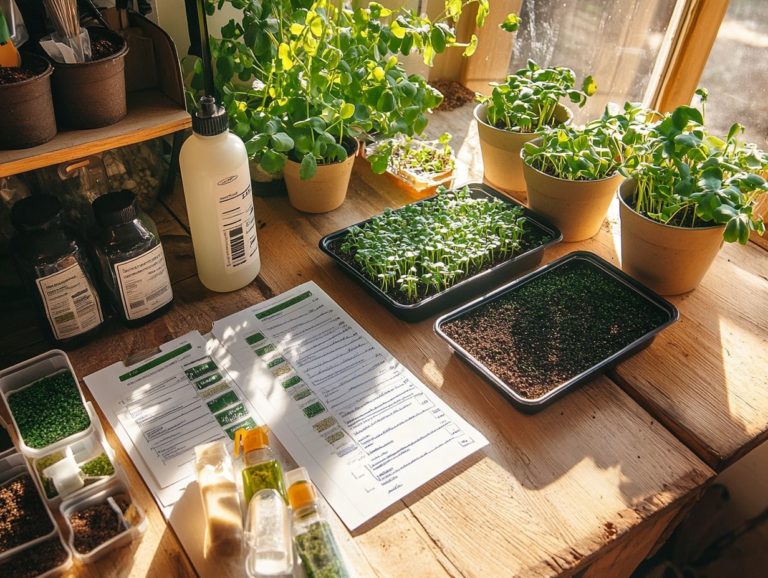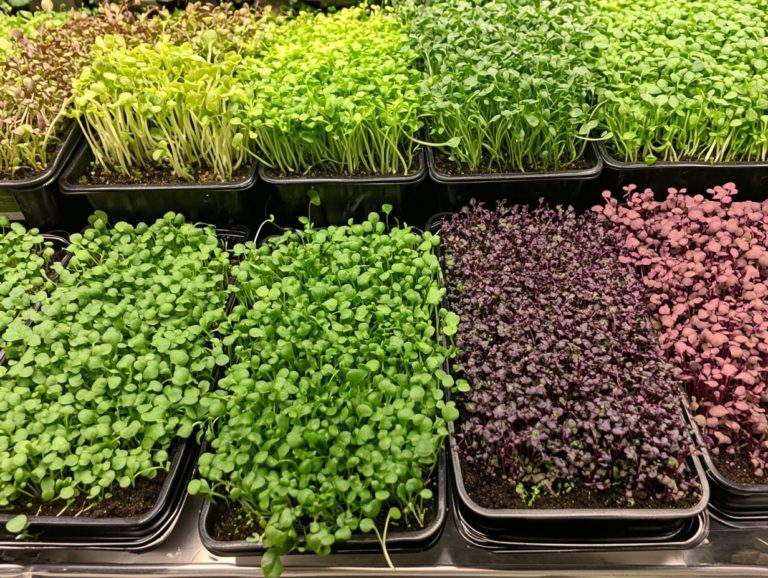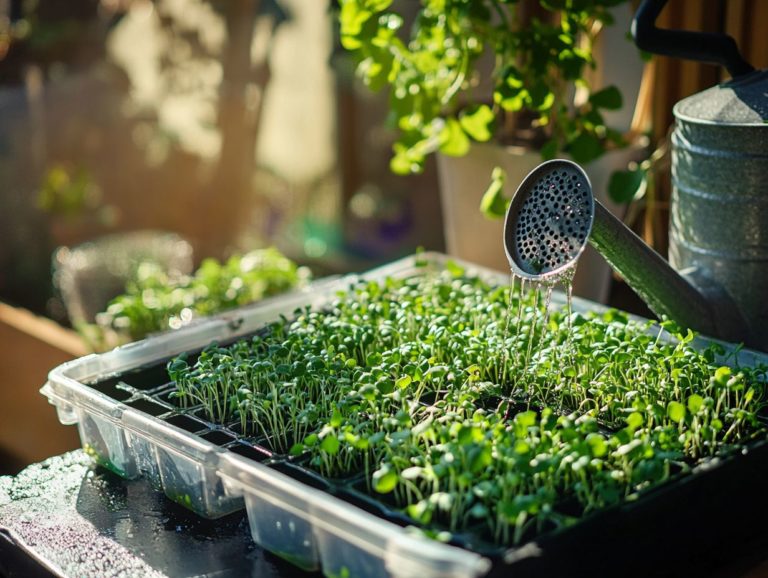How to Build a Microgreen Garden for Kids
Microgreens are petite, nutrient-packed plants that enhance flavor and bring excitement to your garden.
For children, cultivating microgreens offers a wonderful chance to learn about nature, embrace responsibility, and appreciate healthy eating.
This guide will help you select the right plants, gather essential supplies, and follow straightforward steps to create your own microgreen garden.
Engage young minds with activities that foster a deep love for gardening.
Imagine transforming your backyard or kitchen into a lush microgreen oasis!
Contents
- Key Takeaways:
- Choosing the Right Plants for a Microgreen Garden
- Supplies and Tools Needed for a Microgreen Garden
- Step-by-Step Guide to Building a Microgreen Garden
- Activities and Learning Opportunities for Kids
- Frequently Asked Questions
- What is a microgreen garden and why is it beneficial for kids?
- What supplies do I need to build a microgreen garden for kids?
- How do I prepare the container for the microgreen garden?
- What type of microgreen seeds should I use for a kids’ garden?
- How often should I water the microgreen garden?
- What can kids do to help maintain the microgreen garden?
Key Takeaways:
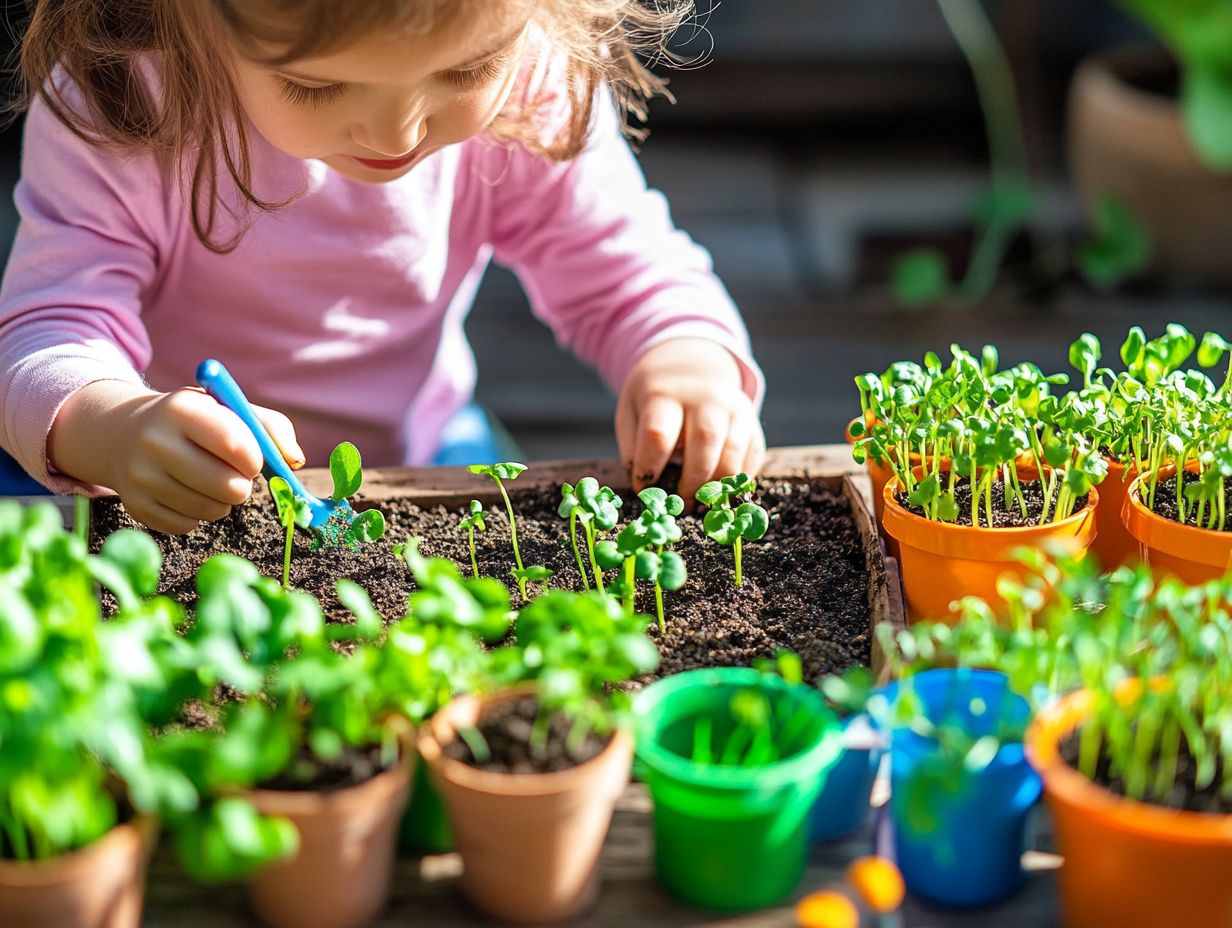
- Introduce kids to gardening with a fun and easy microgreen garden.
- Choose easy-to-grow microgreens and consider indoor vs. outdoor options for a successful gardening experience.
- Through hands-on activities, kids can develop a love for nature and learn about plant growth while enjoying fresh microgreens.
What are Microgreens?
Microgreens are delightful young plants harvested just after germination, bursting with essential nutrients like vitamins, minerals, and antioxidants. They are tiny powerhouses varieties like broccoli sprouts, radish, kale, and arugula elevate the flavor and presentation of your dishes while providing incredible health benefits, including cancer-fighting properties and cholesterol-lowering effects.
Their vibrant colors and concentrated taste make them a perfect addition to Buddha Bowls and other meals, offering a delicious and nutritious option that supports weight management.
You ll love how easy it is to grow microgreens in any small space, whether indoors or outdoors. This accessibility makes them perfect even for those with minimal gardening experience.
The growing process is simple: just sow the seeds in soil or another medium, ensure they get adequate light, and maintain balanced moisture. In one to three weeks, you ll have flourishing greens ready to enjoy.
From mustard greens to cilantro, each variety offers unique flavors and culinary versatility, enhancing everything from salads to sandwiches and soups. The nutrient density of microgreens is remarkable, often surpassing that of their mature counterparts making them the ultimate superfood for health enthusiasts.
Benefits of Gardening for Kids
Gardening, especially growing microgreens at home, offers many benefits for you and your children. It invites them to connect with nature while enjoying invaluable hands-on learning experiences.
By introducing kids to gardening, they can cultivate essential life skills like responsibility and patience, while reaping the health benefits of consuming fresh, nutrient-rich greens such as spinach, basil, and cilantro.
This journey promotes a healthier lifestyle and helps kids appreciate where their food comes from, including the significant nutrients packed in these greens.
Gardening sparks creativity as children design their miniature gardens, making thoughtful decisions about plant placement and care. Engaging with plants enhances their psychological well-being, helping reduce stress and anxiety through the soothing effects of nature.
This hands-on activity encourages outdoor play and movement, while nurturing plants instills a sense of accomplishment as they witness growth and the joy of harvest.
These benefits also shape healthier habits and help forge lifelong connections with the environment, encouraging proactive management of chronic disease through better nutrition.
Choosing the Right Plants for a Microgreen Garden
Selecting the ideal plants for your microgreen garden is a crucial step toward indoor gardening success, especially for beginners. With enticing options like broccoli sprouts, radish, kale, and spinach, choosing easy-to-grow varieties ensures a fruitful experience that can ignite a lasting passion for gardening.
Consider your taste preferences, the health benefits each plant offers, and their growth duration. This thoughtful approach empowers you to cultivate a diverse and rewarding microgreen garden, perfect for enjoyment all year round.
Easy-to-Grow Microgreens for Kids
As you embark on your gardening journey, selecting easy-to-grow microgreens can provide a rewarding and educational experience for your kids. Varieties like radish, basil, and pea shoots are ideal for young gardeners due to their rapid growth and low maintenance. They also pack a punch with vitamins and antioxidants, offering significant health benefits.
These microgreens thrive in well-drained soil and enjoy bright light, making a sunny windowsill or a simple tabletop garden the perfect setting for nurturing them. For those looking to start, following a step-by-step guide to sowing microgreens can be very helpful. Taking care of them is easy; just a little watering and some pest monitoring will keep these greens flourishing, ensuring they are high in nutrients and antioxidants.
Not only are they fun to grow, but they also introduce children to the joys of nutrition. They can easily be tossed into salads, sandwiches, or blended into smoothies. Exploring the vibrant flavors of these varieties can turn even picky eaters into culinary adventurers, instilling a sense of responsibility and accomplishment through their gardening efforts.
Considerations for Indoor vs. Outdoor Gardens
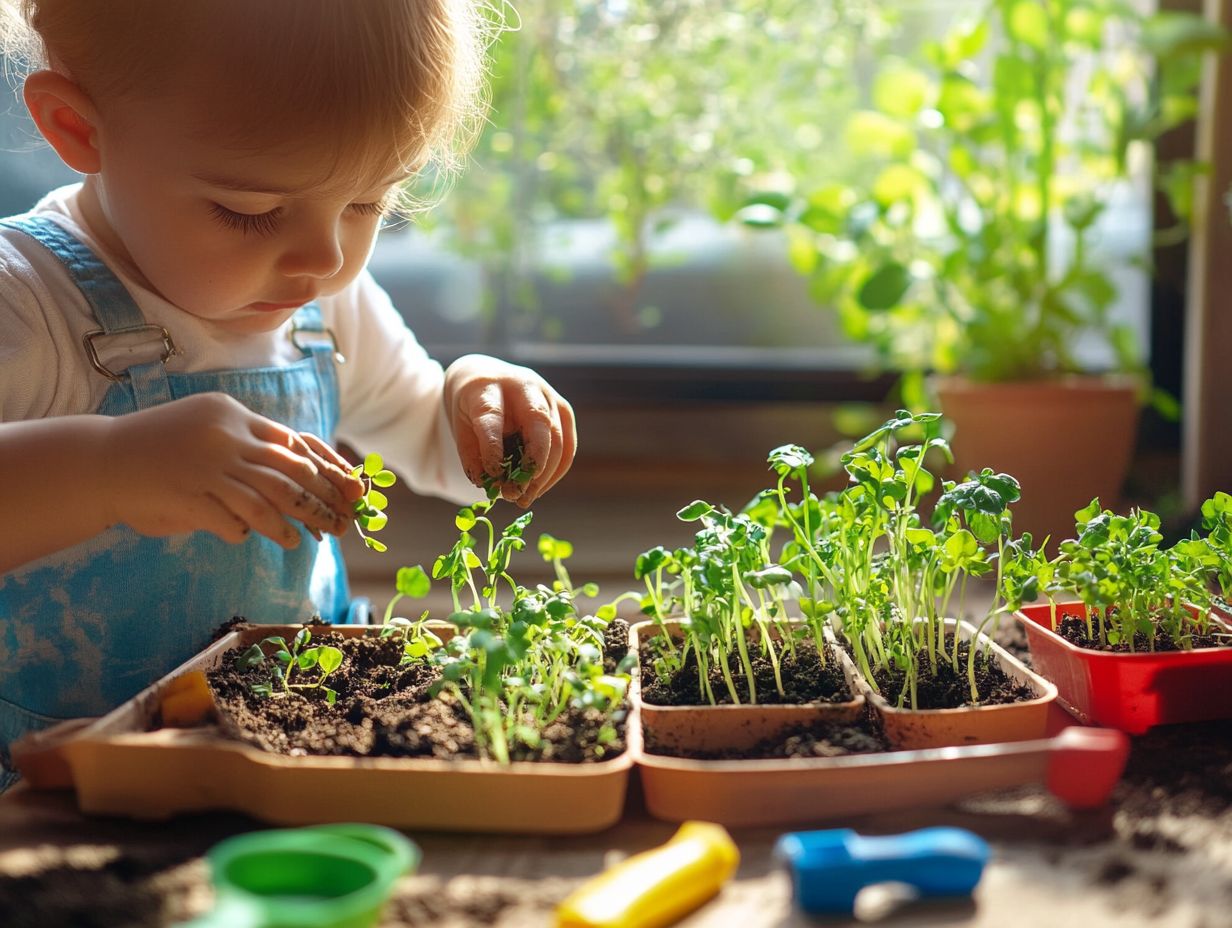
When weighing the options between indoor and outdoor gardens for cultivating microgreens, several key factors can significantly affect the success of your gardening journey, particularly regarding the health benefits of different varieties.
Indoor gardens provide controlled conditions and the luxury of year-round growing, making them perfect for delicate varieties like broccoli sprouts and basil. In contrast, outdoor gardens offer generous space and abundant natural sunlight, elevating growth quality and flavor.
If you choose indoor gardening, you ll love how convenient it is! You can grow microgreens even in cozy apartments or homes with limited space. Indoor setups help keep pests and diseases away, reducing your reliance on chemicals. Meanwhile, outdoor gardens benefit from natural pollination and direct sunlight, which can enhance the taste of your crops.
However, consider that outdoor gardens are subject to climate shifts and may limit your growing season based on local weather. Popular microgreens like arugula and radish flourish outdoors, but some varieties, such as broccoli sprouts, may struggle without the protective embrace of a controlled indoor environment.
Supplies and Tools Needed for a Microgreen Garden
Starting your microgreen garden requires a carefully curated selection of supplies and tools to streamline the growing process, whether indoors or outdoors. A well-equipped microgreens kit typically includes essential items such as trays, soil, seeds, and even light sources. These elements help create the ideal environment for growth.
By ensuring you have the right supplies, including a comprehensive microgreens kit, you simplify the gardening journey and enrich the overall experience, making each step more enjoyable and rewarding. To enhance your growing efforts, consider learning How to Use Hydroponics for Microgreens.
Essential Supplies
Essential supplies are key to establishing a successful microgreen garden. This ensures you have all the necessary components at your fingertips. A typical microgreens kit features items like trays, soil that helps plants grow better, and a variety of seeds. These items allow you to effortlessly cultivate nutrient-packed greens right at home.
These trays are designed to provide proper water movement and air flow, both crucial for healthy root growth. The soil is also very important, supplying essential nutrients. Choosing organic options can enrich the growth environment even more.
Your choice of seeds matters greatly. Different varieties like chard, spinach, and basil offer unique flavors and nutrient profiles, enabling you to create a diverse garden. To enhance the atmosphere, consider adding lighting and a simple watering can to encourage optimal growth conditions. This nurtures these delicate plants to their fullest potential while ensuring they remain packed with nutrients.
Optional Tools for Fun and Learning
In addition to essential supplies for your microgreen garden, optional tools can elevate your gardening experience and create a delightful journey for kids. Consider adding watering cans, plant markers, and even magnifying glasses to engage them further. These tools spark curiosity and help them understand the growth process better.
Integrating colorful, themed watering cans teaches children about the importance of hydration and turns watering sessions into moments of joy. Plant markers offer a wonderful chance to introduce language and spelling. Kids can label their seed varieties, such as broccoli sprouts and arugula, making learning fun. A magnifying glass invites them to explore tiny details, like leaf patterns or root growth, transforming each gardening session into a mini-adventure. Additionally, you can teach them how to grow microgreens in a small space for an exciting indoor gardening experience.
Encouraging the use of a garden journal fosters observational skills and creativity. Kids can document their experiences, instilling a sense of ownership and responsibility. Together, these tools create a rich educational environment that cultivates a genuine love for nature.
Step-by-Step Guide to Building a Microgreen Garden
Building your microgreen garden is an exciting adventure that brings fresh flavors right to your table! Having a straightforward, step-by-step guide makes it easy to navigate the process.
From preparing the soil and choosing the right containers to planting seeds and nurturing your greens, each stage is crucial for achieving a plentiful harvest of nutritious microgreens.
These vibrant additions not only elevate your meals but also play a significant role in fostering a healthier lifestyle.
Preparing the Soil and Containers
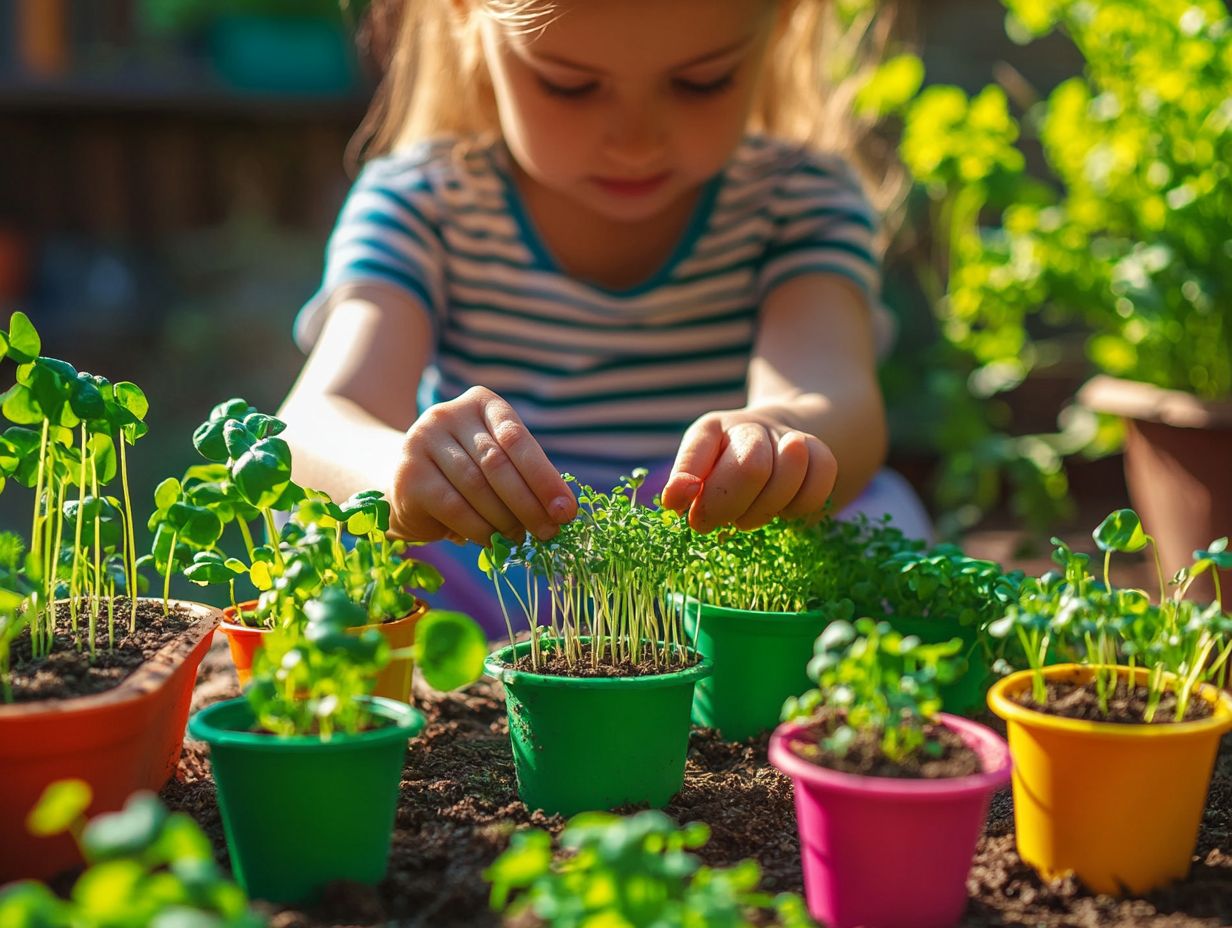
Preparing the soil and containers is an essential first step in establishing a thriving microgreen garden that yields healthy and flavorful greens. Selecting high-quality soil rich in nutrients and appropriate containers that allow water to escape sets the stage for your successful planting. This ensures your microgreens enjoy optimal growth conditions.
To kick off this process, choose organic potting soil specifically designed for seed starting. This soil is lightweight and holds moisture well without becoming waterlogged. Peat-based mixes or coconut coir are also excellent choices, as they promote air flow and support robust root development.
For containers, shallow trays or seedling flats work wonders. Just remember to ensure they have drainage holes. If you re feeling adventurous, repurposed containers can be a great option, but don t forget to sanitize them first.
Adding a layer of perlite or vermiculite at the bottom can further enhance water movement, creating the perfect environment for your delicate microgreens to flourish.
Planting and Caring for Microgreens
Planting and nurturing microgreens requires keen attention and a solid grasp of their ideal growing conditions to ensure a successful harvest! Once you’ve prepared the soil and sown the seeds, it s crucial to maintain proper moisture levels, monitor light exposure, and provide the right care to encourage growth. This unlocks the myriad health benefits these nutrient-dense greens can add to your meals.
When it comes to watering, exercise caution! Too much can lead to mold, while too little can hinder growth. A light misting every few days is ideal, keeping the soil damp without tipping into sogginess.
Microgreens flourish in bright, indirect light for at least four to six hours a day. Windowsills or grow lights are perfect environments for them to thrive!
Managing pests is equally important. Employing organic methods, like neem oil or insecticidal soap (a safe and effective way to manage pests), can help keep unwelcome guests at bay. This allows your microgreens to flourish and stay healthy.
By focusing on these essential details, you ll discover that a bountiful harvest is just around the corner!
Activities and Learning Opportunities for Kids
Engaging children in gardening activities not only fosters a deep appreciation for nature but also opens the door to a wealth of educational opportunities that go far beyond merely planting microgreens!
Through immersive, hands-on experiences, young learners can delve into essential concepts of biology, nutrition, and environmental science. They also reap the remarkable health benefits of the nutritious greens they grow, including lower cholesterol and cancer-fighting properties! This makes the journey both enjoyable and beneficial.
Observing Growth and Development
Observing the growth and development of microgreens can be an intriguing journey, offering profound insights into the life cycle of plants. As you monitor changes from germination (the first signs of life) to harvest, you ll discover valuable lessons about patience and nurturing living organisms, all while delighting in the vibrant spectacle of greens sprouting!
This engaging process fosters your curiosity and encourages hands-on learning, making it perfect for any budding botanist. You can witness how seeds swell, sprout, and ultimately flourish into lush greens, all while documenting your findings in a journal.
This hands-on experience enriches your understanding of biology and builds appreciation for sustainability and healthy eating. With age-appropriate tools, you can actively participate in watering, cultivating, and even tasting your home-grown greens. For those interested in getting started, learning how to create a microgreen grow kit allows you to make meaningful connections between growth and nutrition in a truly immersive way!
Harvesting and Using Microgreens
Harvesting your microgreens is the exciting climax of your gardening journey! Once those greens reach their peak, you can gather them and incorporate them into a variety of dishes, bringing numerous health benefits and vibrant flavors to your meals think Buddha Bowls and refreshing salads!
These petite greens add a splash of color and an impressive array of nutrients, bursting with vitamins and antioxidants. To achieve the best flavor, it’s essential to harvest them just before their true leaves emerge, using clean scissors to ensure you don t inflict any damage.
After harvesting, these delightful gems can elevate everything from sandwiches and wraps to soups and s smoothies. For a quick and delicious recipe, imagine tossing them into a summer pasta salad with cherry tomatoes and a light vinaigrette, delivering a refreshing zing with every bite!
Frequently Asked Questions
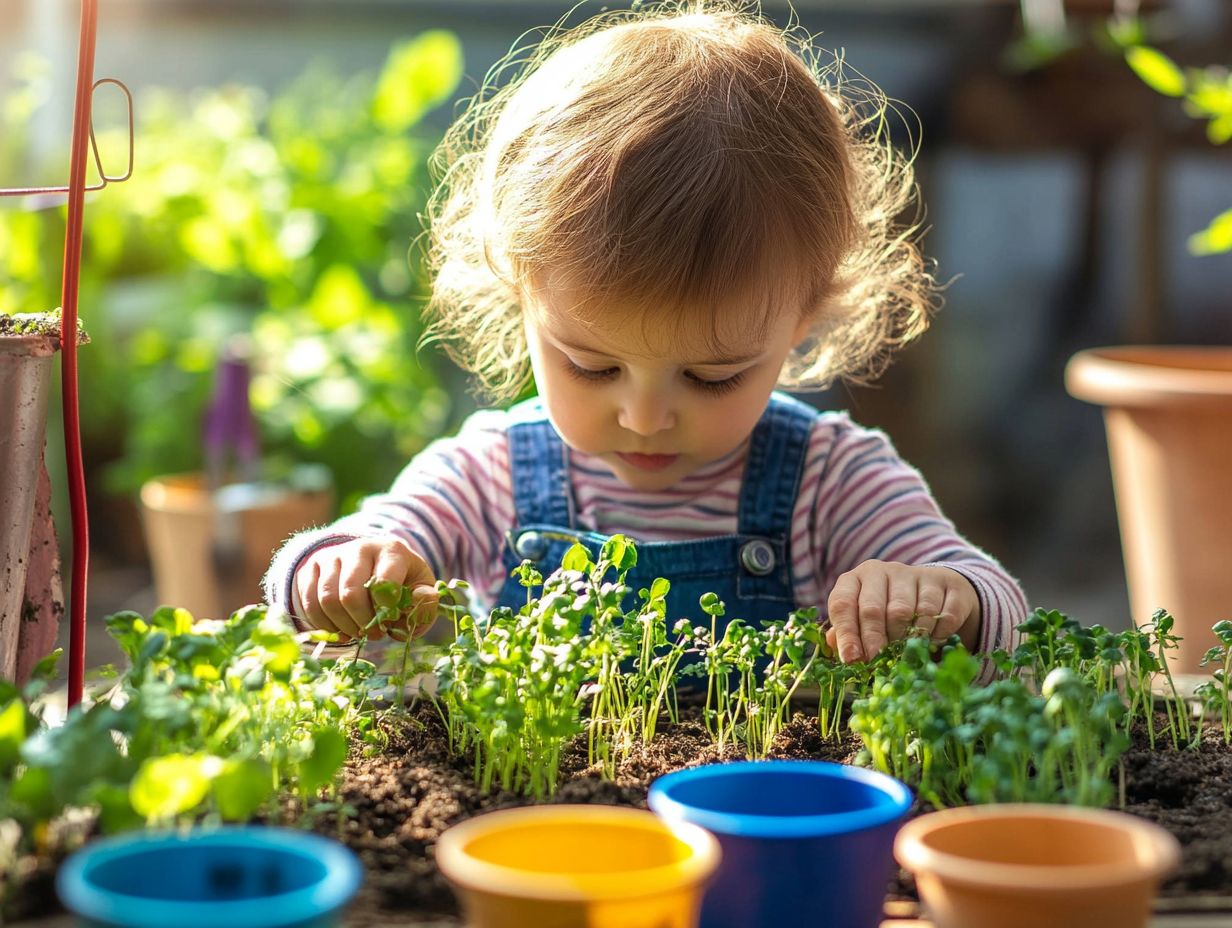
What is a microgreen garden and why is it beneficial for kids?
A microgreen garden is a small garden specifically designed for growing microgreens, which are young vegetable greens. It is beneficial for kids because it is a fun and educational way to teach them about gardening, healthy eating, and responsibility!
Curious about other gardening tips? Stay tuned for more insights!
Ready to start your own microgreen garden? Let s get growing!
What supplies do I need to build a microgreen garden for kids?
You will need a shallow container, potting soil, microgreen seeds, water, and a sunny spot to place the garden. You might also want to grab some fertilizer, a spray bottle, and basic gardening tools for extra fun!
How do I prepare the container for the microgreen garden?
Start by filling the container with potting soil, leaving about an inch of space at the top. Lightly tamp down the soil and moisten it with water.
Gently press the soil to create a flat surface for the seeds to be planted.
What type of microgreen seeds should I use for a kids’ garden?
There are many types of microgreens, but some are easier to grow and more appealing to kids than others. Popular choices include radish, peas, sunflower, and broccoli.
You can also try mixing different seeds together for a colorful and tasty mix. Microgreens are tiny, young plants that are packed with flavor and nutrients.
How often should I water the microgreen garden?
Keep the soil moist, but avoid soaking it. This helps prevent mold or rot. Check the soil daily and water as needed, using a spray bottle or watering can.
What can kids do to help maintain the microgreen garden?
Kids can have a hands-on role in caring for the garden by helping with watering, monitoring growth, and gently tending to the plants.
Kids can also harvest the microgreens when they are ready to eat! Watch as your little ones excitedly harvest their tasty greens!


